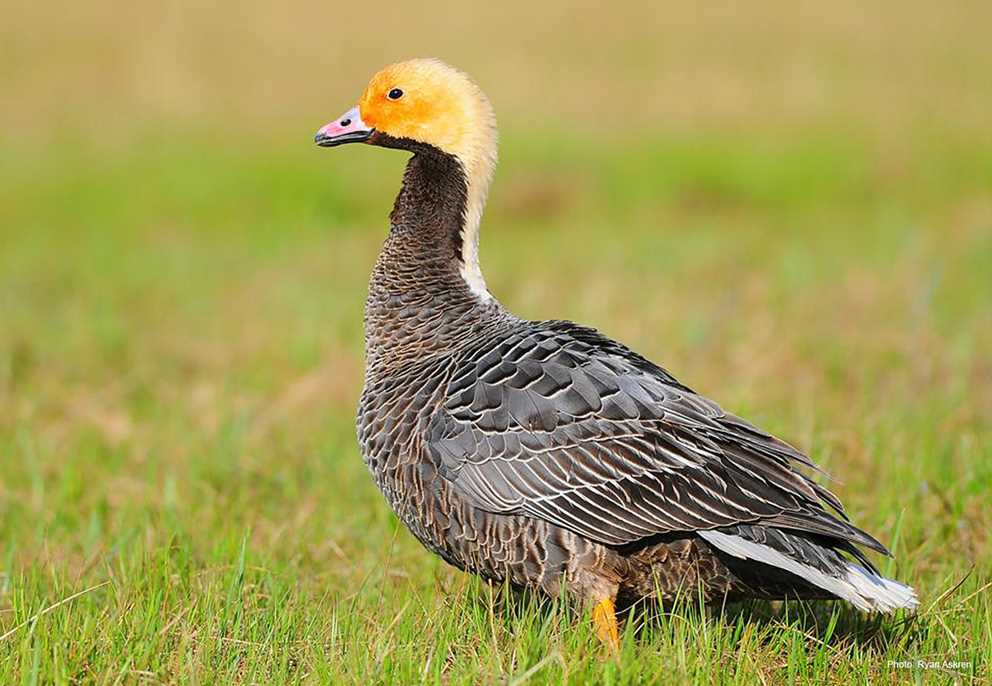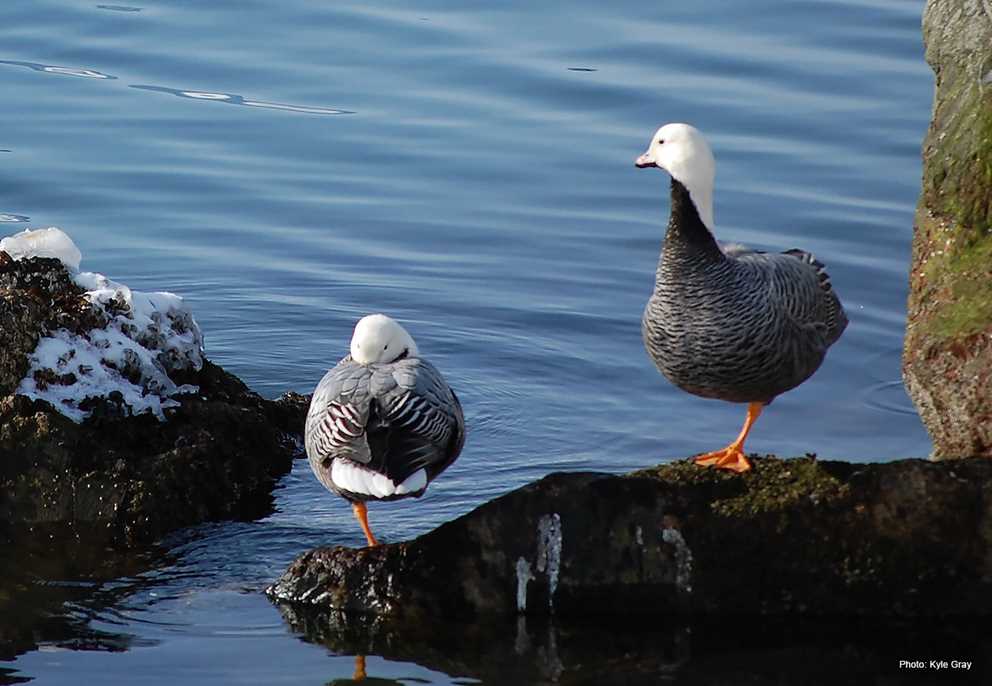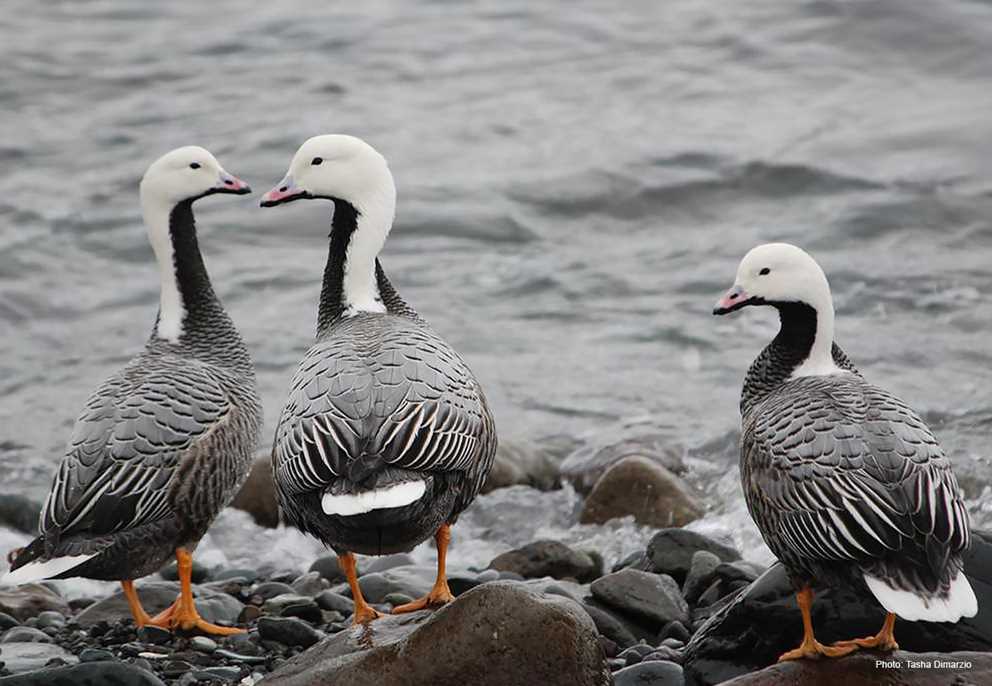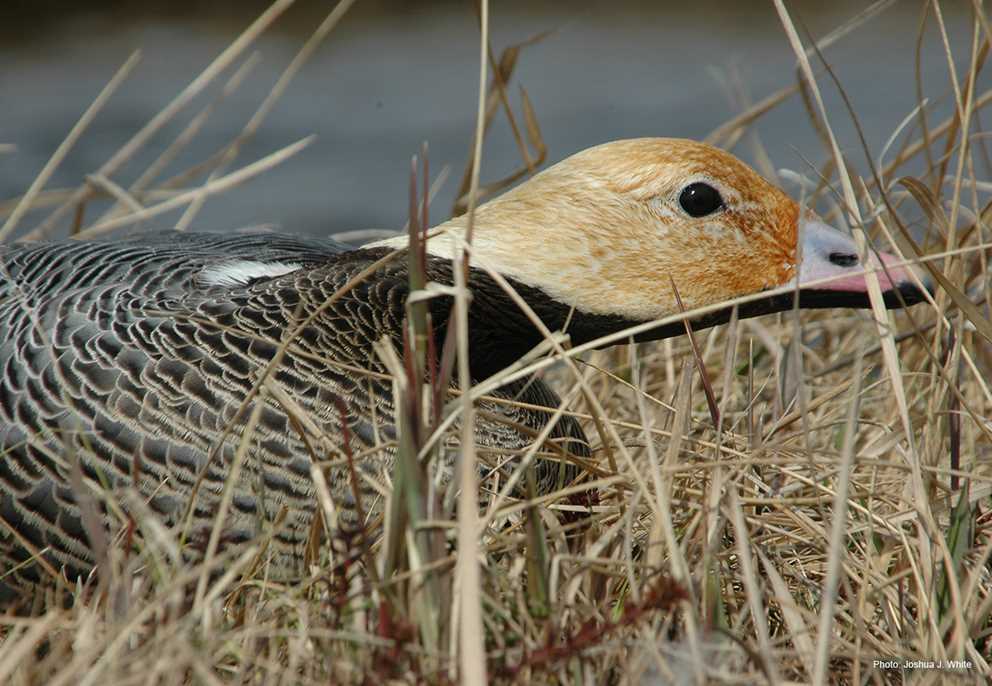Overview
The Emperor Goose is a medium-sized goose that spends nearly its entire life near coastal or marine habitats. It has a restricted range with breeding populations in extreme western Alaska and eastern Russia. Their breeding range in Alaska includes coastal salt marshes of the Seward Peninsula south to the Yukon-Kuskokwim Delta. Their winter range includes coastal area of Kodiak and the Aleutian Islands in Alaska, and the Kamchatka Peninsula of Russia.
Emperor Geese are medium-sized, with a short-necked, stocky appearance. Adults have white heads and hindnecks (sometimes stained orange red), black chins and dark forenecks, gray body plumage with subtle black and white barring, and a dark vent and rump that contrasts with a white tail.
Description
Key Identification Features
- Emperor Geese are medium-sized geese, with a short-necked, stocky appearance.
- Adults have a white head and hindneck (sometimes stained orange red), black chin and dark fore neck, gray body plumage with subtle black and white barring, and a dark vent and rump that contrasts with a white tail. In adults of both sexes, the bill is pink, while the legs and feet are orange.
- Immatures are dark gray, with lighter barring or scaling on the back, with dull yellow legs.
Male/Female Average Length and Weight
- Weight: Males 5.3 lbs.; Females 4.2 lbs.
- Wingspan: 14.9 in.
Male and Female Identification
- Alternate (Breeding) and Basic Plumage: Adults have a bicolored head, consisting of white head and hindneck (sometimes stained orange red), black chins, gray black fore neck, and gray body plumage with subtle black and white barring. They have a dark vent and rump that contrasts with a white tail. Adults of both sexes have a pink bill with orange legs and feet. Immature birds are dark gray, with lighter barring or scaling on the back, with dull yellow legs.
In-flight Identification
- The black trailing edge contrasts with the silvery upperwing, and the white tail feathers are dark above and below.
Vocalizations
- They are less vocal than other geese. Calls are a “kla-ha” or “u-lu.”
Similar Species
- Unique in appearance and not easily confused with other geese in North America. Blue phase or intermediate phase Snow Geese will have an entirely white head and neck, compared to the bicolored head and neck of Emperor Geese. The rare dark morph of Ross’s Goose will have a white belly and undertail coverts and is smaller and stockier. In flight, Emperor Geese have a comparatively rapid wing beat compared to other geese.
Habitat Preferences
- Breeding: Emperor Geese nest in coastal salt marshes of the Seward Peninsula and Yukon-Kuskokwim Delta, usually on river or slough banks. Nests are often in elevated areas with good visibility, with dense grasses, sedges, and other plants.
- Migration and Wintering: During migration and winter, Emperor Geese use large estuaries with intertidal habitats, where they feed extensively on aquatic plants and animals.
Foraging Habits and Diet
- Emperor Geese are omnivorous and feed on a variety of plants including eelgrass, sea lettuce, beach pea, beach rye, and crowberries. They also feed on blue mussels and other intertidal invertebrates during migration and winter.
Breeding Habits
- Monogamy: Emperor Geese maintain monogamous, lifelong pair bonds. The timing of pair formation is poorly known. Some Emperor Geese attempt first breeding at age three, but others may wait until year 4 or later.
- Nest Locations: The nest is usually a scraped area with dead vegetation added as laying progresses, and usually on an elevated area near water in low shrubs and grasses.
- Clutch Size: The average clutch size in North America is 3–6 eggs. The eggs are creamy to dull, elliptical ovate, and average 3.2 by 2.1 in. The average incubation period is 24 days, with females performing nearly all incubation duties. Males provide nest defense.
Migration and Distribution
- Fall Migration: Migration begins mid- to late August, with most birds arriving in Aleutian Island wintering areas by November.
- Spring Migration: In Spring, birds begin migration in February and arrive in breeding areas in mid-April.

Conservation Status
- IUCN Status: Near Threatened
- Population Status: Comprehensive long-term population estimates are lacking. Available data suggest the population declined from over 130,000 in the 1960s to less than 45,000 inthe 1980s. Since 1986, a spring survey in the YK Delta coastal zone indicated an increasing population index from 10,000–15,000 in late 1980s to 25,000–30,000 in the early 2020s.
- Conservation Concerns: Primary threats to Emperor Geese include habitat loss, adverse effects of environmental change, and risks associated with accidental oil spills near key breeding and wintering sites.
- Conservation Focus: Conservation efforts focus on careful population management via informed harvest decisions, egg collecting restrictions, and the protection and responsible use of key breeding and wintering sites
Harvest Information
- Prior to 2017, the hunting season for Emperor Geese had been closed for 30 years. The season reopened in 2017, following a permit system that allowed for the harvest of 500 or 1,000 Emperor Geese, depending on population status.
- Harvest regulations follow the Pacific Flyway Emperor Goose Management Plan which calls for an open season when the spring population index exceeds 23,000. In 2024, the spring index fell to 19,000, leading the USFWS, State, and regional wildlife managers to recommend a closed season on Emperor Geese for the 2025–26 season.
- Emperor Geese are important to indigenous subsistence hunters, with estimated harvest of 1,500–4,500 birds and <500 eggs during years when subsistence harvest is permitted.




